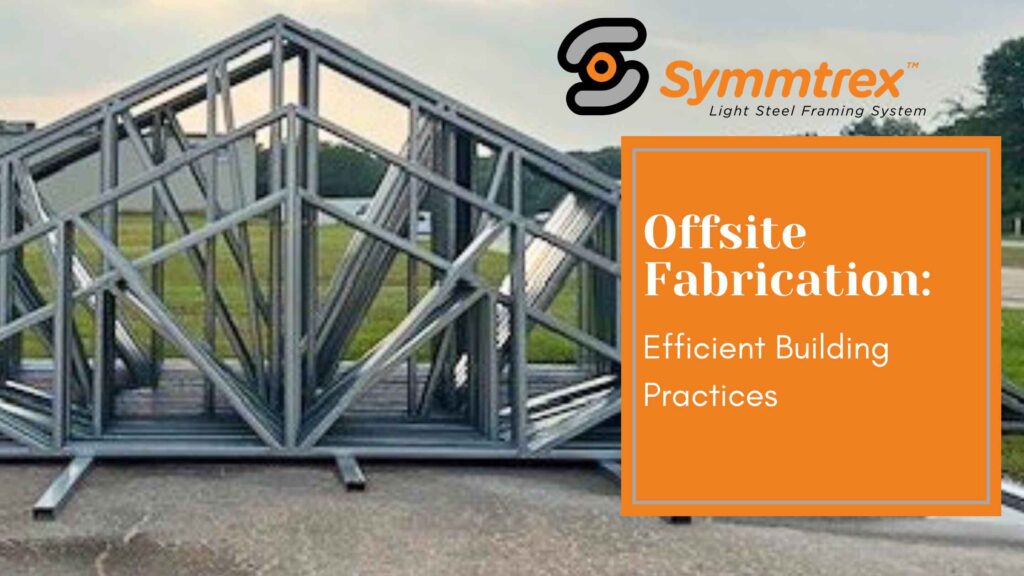In the ever-evolving world of construction, efficiency and sustainability are at the forefront of industry advancements. As project timelines tighten and environmental considerations become increasingly important, the demand for innovative building practices continues to rise. Offsite fabrication has emerged as a key solution, offering numerous benefits that promote efficient building practices. This blog post delves into how offsite fabrication is reshaping the construction landscape by enhancing efficiency, reducing waste, and improving overall project outcomes.

Understanding Offsite Fabrication
What is Offsite Fabrication?
Offsite fabrication refers to the process of manufacturing building components in a controlled factory environment before transporting them to the construction site for assembly. This method contrasts with traditional on-site construction, where all building activities occur directly on the job site. Offsite fabrication encompasses a range of components, from entire modular units to individual elements like walls, floors, and roof trusses.
The Rise of Offsite Fabrication
The construction industry faces increasing pressure to deliver projects more quickly, cost-effectively, and with a smaller environmental footprint. Offsite fabrication offers a solution to these challenges by streamlining the building process and introducing greater predictability and control. Its popularity has surged due to its ability to meet modern demands for sustainability, efficiency, and innovation.
Benefits of Offsite Fabrication in Promoting Efficient Building Practices
Enhanced Efficiency and Speed
One of the most significant advantages of offsite fabrication is its ability to dramatically enhance efficiency and speed up project timelines. By shifting a substantial portion of construction activities to a factory setting, parallel work can occur both on-site (such as site preparation) and off-site (such as component manufacturing). This simultaneous progress significantly reduces the overall construction timeline, often cutting project durations by 30% to 50%.
Streamlined Workflows
Offsite fabrication introduces a level of precision and consistency not easily achievable with traditional methods. The controlled factory environment allows for better coordination, reducing the likelihood of delays caused by weather, labor shortages, or unexpected on-site complications. This streamlined workflow ensures that projects remain on schedule and within budget.
Cost Savings
Efficient building practices enabled by offsite fabrication lead to substantial cost savings. The factory setting minimizes material waste through precise cutting and efficient use of resources. Additionally, the accelerated project timelines reduce labor costs and mitigate the financial impact of potential delays. The predictability of offsite fabrication also supports more accurate budgeting and financial planning.
Reduced Material Waste
Traditional construction methods often result in significant material waste due to inefficiencies and on-site errors. In contrast, offsite fabrication’s precise manufacturing processes ensure optimal material usage, reducing waste and contributing to cost savings.
Improved Quality Control
The factory environment inherent to offsite fabrication allows for stringent quality control measures throughout the production process. Components are manufactured under consistent conditions, ensuring high-quality standards and minimizing the risk of defects. This level of quality control translates to more durable and reliable building components, enhancing the overall integrity of the constructed facility.
Consistency and Precision
Offsite fabrication leverages advanced technologies such as computer-aided design (CAD) and computer-aided manufacturing (CAM) to achieve unparalleled precision and consistency. These technologies enable the creation of components that fit together seamlessly, reducing the need for on-site adjustments and rework.
Sustainability and Environmental Benefits
Efficient building practices are closely tied to sustainability, and offsite fabrication excels in this regard. The method’s ability to optimize material use and reduce waste significantly lowers the environmental impact of construction projects. Additionally, the reduction in on-site activity minimizes disturbances to the surrounding environment, preserving natural habitats and reducing noise pollution.
Energy Efficiency
Offsite fabrication facilities often employ energy-efficient practices and technologies, further reducing the carbon footprint of the construction process. The resulting buildings are designed with energy efficiency in mind, incorporating features such as enhanced insulation, energy-efficient windows, and sustainable materials.
Overcoming Challenges with Offsite Fabrication
Navigating Logistical Considerations
While offsite fabrication offers numerous benefits, it also presents logistical challenges, particularly regarding the transportation of prefabricated components to the construction site. Careful planning and coordination are essential to ensure that modules arrive on time and in good condition. Advances in logistics and transportation technology are continually improving the feasibility of offsite fabrication for a wide range of projects.
Cultivating Industry Acceptance
The transition to offsite fabrication requires a cultural shift within the construction industry. Overcoming traditional biases and demonstrating the tangible benefits of this approach are crucial for its wider adoption. Success stories and case studies play a vital role in changing perceptions and showcasing the potential of offsite fabrication.
The Future of Construction with Offsite Fabrication
As the construction industry continues to evolve, offsite fabrication stands out as a key driver of change, promising a future where projects are completed more efficiently, cost-effectively, and sustainably. Its alignment with modern demands for high-quality, environmentally responsible construction practices positions offsite fabrication as a transformative force in the industry.
In conclusion, the benefits of offsite fabrication in promoting efficient building practices are clear. From enhanced efficiency and cost savings to improved quality control and sustainability, offsite fabrication is revolutionizing how we approach construction. By embracing this innovative method, builders and developers can unlock new levels of performance and value for their projects, paving the way for a smarter, greener, and more efficient construction industry.

